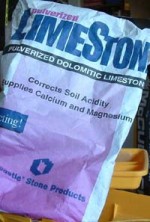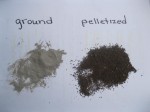 If you live in an area where the soil is naturally acid you will probably need to apply lime to lawns and garden beds. Some plants like azaleas thrive in acid soils but grasses and many garden plants need a more neutral soil. In addition to correcting soil acidity, lime furnishes two important plant nutrients (calcium and magnesium), reduces the toxicity of some materials that may cause poor plant growth, promotes the availability of some desirable plant nutrients, and improves soil structure by increasing bacterial growth. It is NOT a fertilizer and should not be used instead of one; it is a soil amendment that is used primarily to correct soil acidity problems. For information on soil acidity see KarensGardenTips Soil pH: Understanding, Testing, Changing and Plant Requirements.
If you live in an area where the soil is naturally acid you will probably need to apply lime to lawns and garden beds. Some plants like azaleas thrive in acid soils but grasses and many garden plants need a more neutral soil. In addition to correcting soil acidity, lime furnishes two important plant nutrients (calcium and magnesium), reduces the toxicity of some materials that may cause poor plant growth, promotes the availability of some desirable plant nutrients, and improves soil structure by increasing bacterial growth. It is NOT a fertilizer and should not be used instead of one; it is a soil amendment that is used primarily to correct soil acidity problems. For information on soil acidity see KarensGardenTips Soil pH: Understanding, Testing, Changing and Plant Requirements.
Since lime is slow acting, fall is a good time to apply it so that the lime has time to work its magic through the fall and winter in time for spring planting. Take soil samples from your lawn and garden, test for acidity using a simple “home” testing kit, or take them to your county extension office for testing. This is free in some states and you will get information not only on the acidity of your soil but about how much lime you need to add to grow whatever you want to grow in various areas.
After you get the results and recommendations from your soil tests go to a garden center or big box store to get lime. Lime is made from limestone. You will probably have several choices

 Pulverized limestone: This is a dusty product that is difficult to apply but is usually the cheapest. Distribution requires a spreader designed to regulate the flow of fine powder-like material evenly over the ground. Because of the very fine particle size it is faster acting than other forms of limestone.
Pulverized limestone: This is a dusty product that is difficult to apply but is usually the cheapest. Distribution requires a spreader designed to regulate the flow of fine powder-like material evenly over the ground. Because of the very fine particle size it is faster acting than other forms of limestone.
 Pelletized limestone: Because of the difficulties of spreading pulverized lime, producers have made lime in the form of small pellets that are much easier to spread. A cyclone-type spreader works best; but limestone in pelletized form can also be spread effectively by hand.
Pelletized limestone: Because of the difficulties of spreading pulverized lime, producers have made lime in the form of small pellets that are much easier to spread. A cyclone-type spreader works best; but limestone in pelletized form can also be spread effectively by hand.
 Dolomitic limestone: All lime contains calcium carbonate; in addition, dolomitic limestone contains a significant amount of magnesium carbonate (about 50%). If your soil test indicates a magnesium deficiency then use the dolomitic limestone.
Dolomitic limestone: All lime contains calcium carbonate; in addition, dolomitic limestone contains a significant amount of magnesium carbonate (about 50%). If your soil test indicates a magnesium deficiency then use the dolomitic limestone.
 Hydrated and Burned lime are very quick acting but are hazardous and unless you have respiratory and spreading equipment designed for this product it is best to avoid them. These forms of lime are generally used in an agricultural setting and specialized equipment is used.
Hydrated and Burned lime are very quick acting but are hazardous and unless you have respiratory and spreading equipment designed for this product it is best to avoid them. These forms of lime are generally used in an agricultural setting and specialized equipment is used.
All limestones will need water to dissolve and neutralize acidity so soil moisture and rainfall will significantly influence the speed at which the limestone will work. In addition, limestone will not move horizontally in the soil so an even application is essential. Fall is a great time to get this processes started but winter or spring are possible times if the fall passes you by. Liming your soil can be a relatively cheap and easy way to improve the appearance of your lawn and garden so start the soil testing process soon so you can get the most benefit from your money and labor.